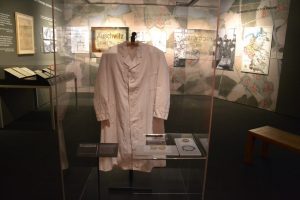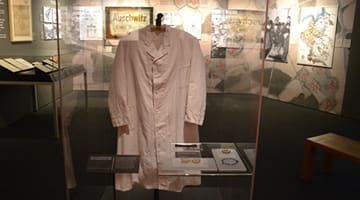Symbols. The ancient world had symbols for fertility, wealth, birth and death. Today’s world is replete with them. The blue-and-

white wheelchair occupied by a stick figure. The red circle with a line imposed over a black lit cigarette. The peace sign. The list is endless.
The power of symbols endures because symbols are creative, useful tools in generating awareness and building knowledge. Interestingly, using a symbol does not bring about conditions. Rather, the primary central reason for how a particular symbol is seen lies in its use over time. Symbols give form to concepts and ideas, thereby defining a world.
The white coat is an excellent example.
For over 100 years, the white coat has served as the physician’s symbol. A child’s earliest memory of a doctor is the person in the white coat. In fact, at almost all medical schools – 97% to be specific – the first symbolic act is the “White Coat Ceremony (WCC).” This rite of passage for medical students, which was created in 1993 by Dr. Arnold P. Gold at Columbia University College of Physicians and Surgeons, entails a “ceremonial cloaking” as one embarks on a medical career. It is combined with the recitation of the Hippocratic Oath. Some health care training programs for Physician Assistants, Occupational Therapists and others conclude with the WCC.
The WCC is a once-in-a-lifetime milestone. Spouses, parents and others flock to watch their loved one’s big moment.
How did the White Coat come into being?
In the late 19th century, physicians wore black because it connoted more somber attire. Medical encounters then were rather solemn in nature as seeking medical advice was considered the last step in life. With the advent of the new century, medicine began to shift from home remedies and more into the realm of bioscience.
Further, the Flexner Report of 1910, which was published under the aegis of the Carnegie Foundation, called for restructuring medical education around laboratory science, in addition to other recommended changes. Physicians – both full-fledged and those in training to-be-physicians – embraced the White Coat as a way to distinguish themselves from the quacks and snake oil healers who shunned evidenced-based medicine.
As the field of medicine evolved and changed in the 20th century, the White Coat emerged as the symbol of medical authority and respect. It is an uniform that elicits trust and respect.
The closing years of the 20th century witnessed some doctors choosing not to wear the White Coat after their professional training had concluded. In particular, pediatricians and psychiatrists said many patients found it too intimidating and distancing from patients. Others said that the coat, unless washed regularly, is a “hotbed” of germs.
Today’s statistics show that 72% of hospital physicians and almost all medical students wear White Coats at least 75% of the time. It sure is an easy way for people to determine that they are medical professionals. In a study conducted by the University of Michigan, over one-third of the 4,062 patients who were polled said that the White Coat influenced their satisfaction with the care rendered.
Unfortunately, and tragically, there are demented minds that have misused and abused this symbol of professionalism, caring and trust.
Recently, my wife and I visited the Museum of the Jewish Heritage in New York’s Battery Park City to tour exhibition “Auschwitz. Not Long Ago. Not Far Away.” This well done exhibit with 700 original objects and 400 photographs, including a cattle car that transported Jews and others to the Nazi death and concentration camps, is engaging, jarring, thought-provoking and gut-wrenching.
It was a horrifying moment for me to come to a display case with a White Coat. Yes, you read this correctly. A White Coat.
The person who wore the White Coat was Dr. Georg Renno. Renno (forgive me but he does not deserve the title “Doctor”) was born in Strasbourg and studied medicine in Munich and Heidelberg. He became an assistant doctor in the Leipzig-Dosen hospital under Hermann Paul Nitsche, a psychiatrist who subscribed to “racial hygiene” and was one of the Nazis’ proponents of murdering patients deemed “unfit” or “unhealthy.” Renno was deputy head of the Harthein killing center (he checked people shortly before they were murdered) and was responsible for the introduction of gas. He also was in charge of Hartheim’s children’s ward and assured that all physically and mentally disabled children were murdered for the sake of racial hygiene. After World War II, Renno worked for the pharmaceutical company Schering. In the 1960s, he was tried for war crimes and was, unfortunately, not convicted. In 1975, the trial against him was shelved because he was unable to stand trial. Right up until his death in 1997, he proclaimed his innocence.
The thought that Renno paraded around in a White Coat while plotting and planning the deaths of innocent people is too much to comprehend. Renno and murderers and perpetrators of his ilk use a powerful symbol to deceive, to trick us into believing that that which they represent is actually present or real. They trick us when we believe that whoever wears the symbol embodies that image because we believe that the symbol and the person are one and the same. What a hoax. What a perversion of the Hippocratic Oath.
The takeaway lesson from Renno’s White Coat should be that whatever we take on in life should be with the highest level of integrity. We don’t always know the answers – and nor are we expected to. The White Coat Ceremony with the recitation of the Hippocratic Oath is at the beginning of one’s medical education. It is the goal of a long journey. But having that goal is so important in all matters in life.
As always, daven.
The words of this author reflect his/her own opinions and do not necessarily represent the official position of the Orthodox Union.
